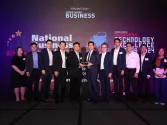Alstom and Saft provide EDF with an innovative system of energy storage batteries
Frequency regulation is becoming serious business.
Alstom-Saft consortium contributes to the first demonstration launched by EDF on a megawatt scale for frequency regulation using a lithium-ion battery storage system.
The Alstom-Saft consortium has signed a frame contract with the EDF group to supply an initial energy storage system using a container of Lithium-ion (Li-ion) batteries, demonstrating the system’s ability to regulate the frequency of the grid. Alstom's MaxSineTM eStorage solution, connected to Saft's Intensium® Max 20M storage system, will be installed on EDF R&D's experimental "Concept Grid", dedicated to the development of grids and smart electrical systems. Located on the EDF site of Les Renardières south of Paris (Seine-et-Marne region), this is the first installation of its kind in France. The storage system and the power converter will be delivered in late 2014.
Frequency is an indicator of the grid stability; it represents the balance between energy produced and energy consumed. To maintain this balance (and therefore the frequency), the operator uses the energy available through the primary reserve, mainly ensured by thermal or nuclear power plant operators, by blocking part of their production capacity.
Battery storage systems provide producers and grid operators with more flexibility over the energy supply immediately available. In the event of an imbalance between production and consumption, the storage system can either release energy into the grid, or store it in a few hundred milliseconds, thus controlling the frequency of the network. The experiments by EDF R&D will evaluate the ability of such a system to regulate the frequency, and particularly the adjustment potential of the primary reserve.
As part of this contract, Alstom and Saft provide the complete 1 MW/30min energy storage and conversion system. Saft will supply its Intensium® Max 20 foot lithium-ion battery container, while Alstom will install its MaxSineTM eStorage solution. Alstom's MaxSineTM eStorage includes a power converter that connects the Direct Current (DC) battery to the Alternating Current (AC) grid, and converts the electricity between DC and AC to be stored or released into the grid. It also includes real-time energy storage management software to optimise the production of electricity according to the needs of the grid.
"The battery energy storage system is part of the ‘Nouvelle France Industrielle’ project, a scheme launched by the French government in 2013," says Patrick Plas, Senior Vice-President, Smart Grid & HVDC at Alstom Grid. "At the cutting edge of smart grid and power transportation infrastructure optimization technologies, Alstom Grid is contributing its technological expertise to the excellence of the French and European energy industry."
"Saft is delighted today to be providing the first battery for primary frequency control installed in France," said François Bouchon, Director of the energy storage activity at Saft. "With our international experience in the integration of renewable energies especially for networks in the Paris area, this innovative experiment will demonstrate the added value of a battery storage system and the performance of Li-ion technology in this promising sector."
Alstom and Saft have already collaborated on the smart grid demonstration project Nice Grid (in Nice, France), installing in late 2013, a 1 MW battery energy storage system to address the risk of grid instability in the event of a massive influx of intermittent solar energy.








![Cross Domain [Manu + SBR + ABF + ABR + FMCG + HBR + ]](https://cmg-qa.s3.ap-southeast-1.amazonaws.com/s3fs-public/styles/exclusive_featured_article/public/2025-01/earth-3537401_1920_4.jpg.webp?itok=WaRpTJwE)
![Cross Domain [SBR + ABR]](https://cmg-qa.s3.ap-southeast-1.amazonaws.com/s3fs-public/styles/exclusive_featured_article/public/2025-01/pexels-jahoo-867092-2_1.jpg.webp?itok=o7MUL1oO)









 Advertise
Advertise


